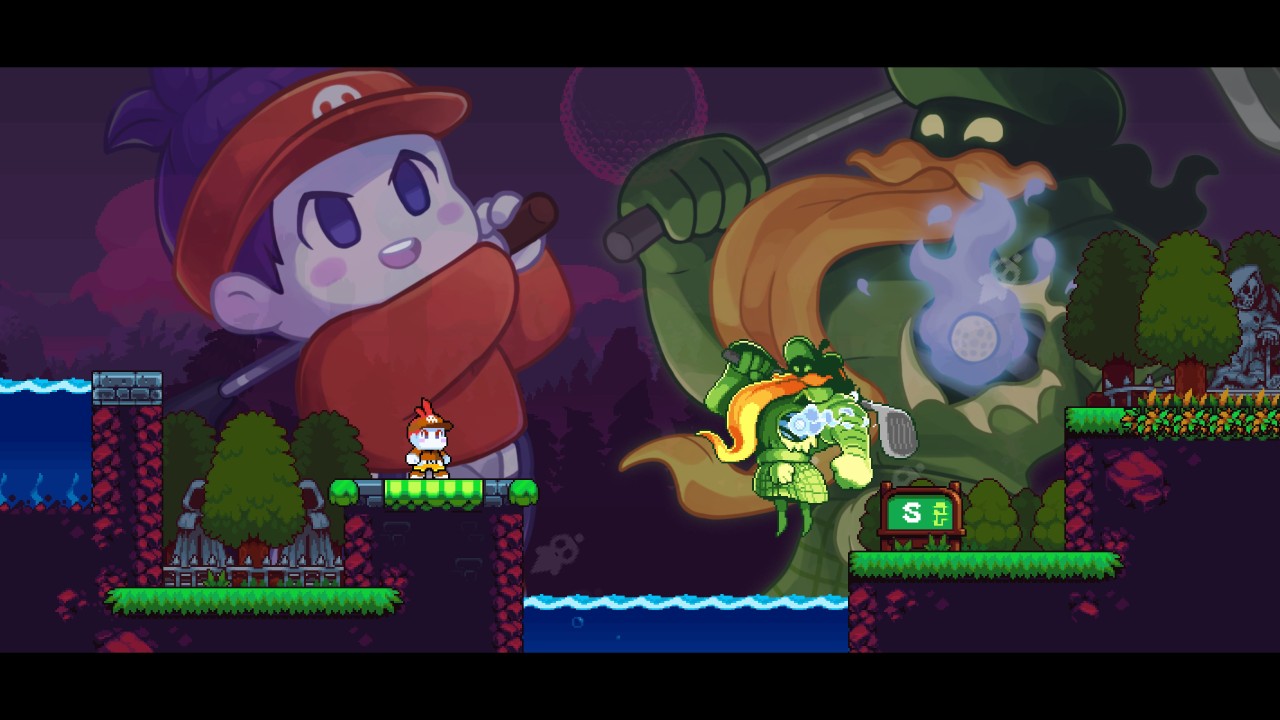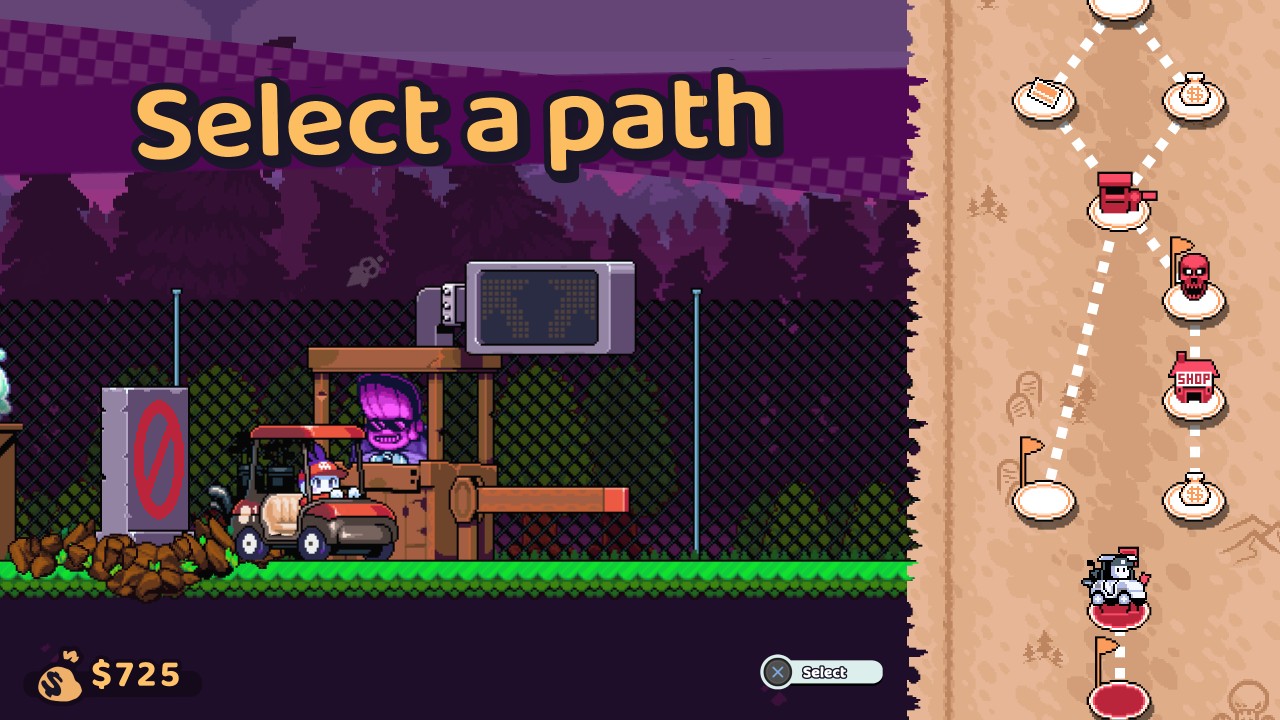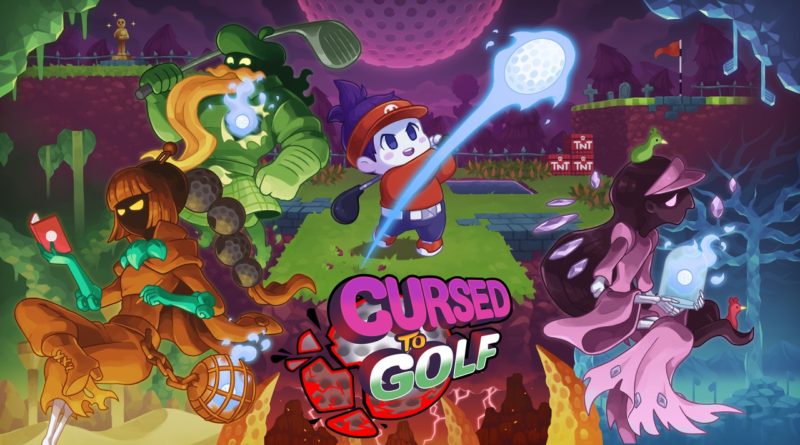Cursed to Golf Review (PS5) – Fairway to Heaven
Is Cursed to Golf’s mix of arcadey gameplay and roguelike mechanics a hole-in-one or hitting below par? The Finger Guns Review:
If there’s a genre that’s boomed in popularity in the modern gaming era, it’s the roguelike. I think most people will have played a game with roguelike elements by now, with many games borrowing at least a bit from the genre. All this to say, unique blends of this gameplay are getting harder to come by.
Enter Cursed to Golf: a mix of the simple arcadey elements of golf titles like Mario Golf with the randomised, run-based gameplay of roguelikes.
Tee Time
The setup for Cursed to Golf is pretty simple. You play as “The Champ”, a pro golfer who is struck by lightning during the final hole of a championship golf tournament. They find themselves whisked away to Golf Purgatory and have to beat an 18-hole course that spans 4 unique areas, with a layout that resets should you fail, thanks to a mischievous Greenskeeper. If The Champ can sink all 18 holes, they get a second shot at life.
It’s a simple but effective opener that immediately sets the lighthearted tone, and the presentation in Cursed to Golf is an immediate high point. The sprite work is chunky but detailed, with character art giving me some Shovel Knight vibes with their respective animations and colour schemes. Cursed to Golf just looks lovely, and the chiptune soundtrack nicely compliments the arcadey gameplay, although it can get repetitive on longer holes. But how does it play?
Know the Basics
Once you’ve entered Golf Purgatory and given the setup, Cursed to Golf quickly pushes you through a tutorial to explain the rules The Champ will need to learn to win their life back.

The core elements of Cursed to Golf’s gameplay are very familiar if you’ve ever played a golf game: pressing X will fill a rising power bar to set your shot strength. Press it again to choose the angle of your shot, shown by a dotted arc to show where your ball will fall. You have 3 clubs to choose from: a Driver, which hits the furthest and the hardest; an Iron, your mid-range club with a much shallower angle to get through tight spaces; and a Wedge, for high-angle, low-power controlled shots. You can also press circle to zoom the camera out and check your environment for hazards and safe ground. I did find that sometimes my ball would land in hazard zones when it looked like I was safe, particularly in the final area. It’s not a huge issue once you become aware of it, but I did find myself getting frustrated a handful of times when the ball landed on the edge of a hazard that wasn’t clear. You’ll use these tools throughout the game, but you’ll need to use the game’s advanced mechanics if you want any chance of winning.
You’ll quickly unlock the ability to add spin to your shots. Once you’ve hit your shot, repeatedly pressing X will increase the amount of spin you’ll apply to the ball. Then you choose which direction you want the ball to move when it lands, and you have control over this until it stops. It’s a skill you’ll use a lot, and it’s necessary if you want to hit above par in the later courses.
The Par Count is an ever-present element in the centre of Cursed to Golf’s UI, and it essentially acts like a life system rather than the traditional par rules. Each shot decreases your Par Count; hit 0, and your run ends. But these holes aren’t traditional courses: they’re filled with hazards. Some are traditional, like bunkers or water, and they just reset your shot. But you’ll soon encounter spikes, piranha-infested waters and fake holes that will each take an extra hit on your Par Count as a penalty. To make up for this, however, each hole is littered with Shot Idols: little statues you can destroy to add to your Par Count. Silver idols give you +2, while gold ones give +4. The silver variants are more common, and they’re always worth hitting if they’re in your path, but I did find that they’re sometimes a bit out of the way, making them not worth the effort as you’ll waste both shots it gives you trying to get it. The gold idols, however, are worth getting: +4 to your Par Count is always helpful.
There are also objects in each of Cursed to Golf that will help you out. Pipes and teleporters will get you closer to the hole, but they’re often trickier to reach. TNT blocks can be destroyed to clear a quicker path, but they’ll blast your ball away. There’s a little risk-reward element in these optional paths: do you take the chance on getting to these harder-to-reach areas to get a quick win or the safer route that will take longer but likely have more idols to compensate? The higher your Par Count, the more cash you’ll receive when you hit the hole.
Ace in the Hole
The cash you earn from beating can be spent in the stores that appear along the path to the 18th hole. These stores let you change The Champ’s colour scheme, but more importantly, they’re where you can purchase booster packs of Ace Cards. Ace Cards are single-use cards that grant various effects during a hole, and they’re your best chance at getting through the more difficult holes found in the later stages of a run.

They range from simple, like adding extra shots to your Par Count, getting a mulligan, or blowing up nearby TNT blocks without having to hit them, to more advanced effects, like redirecting your ball in mid-air or getting to hit 3 balls and picking which one you want to move on with. You’ll unlock more Ace Cards as you reach new areas, and they’ll then become available to use in earlier areas on subsequent runs. These include the ability to place a pair of portals to get to otherwise unreachable areas, ice balls that will freeze pools of water to create a space to take your next shot from or a ball that will drill through solid dirt. There’s a card album at the shop to stock up to 40 cards for further runs instead of losing them when a run ends. It’s a nice little feature, but I found it much better to keep all my cards on me: better to have them and not need them than need them and not have them.
While most of the Ace Cards are inventive and genuinely handy, I did find a few of them to be a little useless. For instance, one card lets you take a practice shot, but there’s a timing element involved in your swings, so it’s unlikely that you’ll make the same shot after the practice shot. I also found the drill shot card would exit the dirt at a weird angle, so it made it a bit of a crapshoot as to where it would land. There’s also a little meter above your Par Counter that shows how much time you have left before your Ace Card ability runs out, but it was difficult to watch both that and the ball, so I’d occasionally run out of time to use the power, and I’d lose the card in the process.
Runs play out across 4 areas, each with its own boss, unique hazards and visual style. Instead of holes being randomly generated, there are over 70 handmade holes that will be randomly picked when you start a run. However, because each area has its own visuals and hazards, you will see repeats of these stages pretty quickly. Between holes, you will run into stores and treasure chests that will give you either extra cash or a card pack. The path will branch, shown as a little barrier. I found I’d accidentally pick the wrong route because I’d always expect a “press X to interact” prompt that every other interactable object has along the path. It’s an inconsistency that I don’t quite understand. The most common choice at these gates is to pick between an easy route, usually a single hole or a tougher one that gives you a couple of treasure chest spots but is followed by a Cursed Hole. These Cursed Holes will throw a modifier at you every few turns, like forcing you to shoot in a single direction for a couple of turns or flipping the screen upside down. They’re definitely more of a challenge, but I never found the rewards for picking that route worth the extra time and difficulty the Cursed Holes entail.
You also earn 3 extra abilities, one for beating each of the first 3 of Cursed to Golf’s 4 bosses, and each helps speed up your journey to the last 3 holes and the boss of the final area. These play out as turn-based races to the hole, with each boss having a unique gimmick. Special Idols appear that, when broken, will stun the boss for a turn, giving you an extra shot. They’re all pretty handy and helped speed up the very long time it would take to get even halfway through a run in the beginning. The first lets you set a single checkpoint after a completed hole once per run, letting you restart from there instead of the very start. The second ability gives you an additional 5 shots PER HOLE the first time your Par Count hits zero. The final ability lets you take your Ace Cards with you when you lose a run instead of losing them all. Not only are each of these abilities genuinely useful, but the boss fights you play to earn them are probably the best courses in the game. The only issue I had with them is that you only get to beat them once, and then you just play a regular hole instead on any subsequent runs. I get why they don’t make you do them again in a run, but even an option to replay them would have been a great little addition given how fun they are. (I also think a multiplayer mode would be neat, given they already have the competitive element in the boss fights. It’s obviously neither a positive nor a negative, just a fun idea that could’ve been a fun addition.)
Rough Around the Edges
I’ve had a lot of good things to say about Cursed to Golf, but for me, it never went beyond good. I have a lot of issues, a lot of which I’ve dotted about above, but the biggest ones get their own section.

My biggest problem is that even with the abilities you eventually unlock from the bosses, runs are still very long. Initially, it took me upwards of an hour to even get to hole 9, but as you unlock more cards, it does get shorter. My final run was around 90 minutes, about half of which came from the massive difficulty spike the last area has. It earns that difficulty to an extent, paying off nicely in its final hole, but there is one hazard in the final 3 stages with a very harsh penalty, with the levels being so long that they have checkpoints to compensate.
While I liked the boss fights in general, one has an ability that felt genuinely unfair. The game even highlights it as cheating, and I get the intent was to make your victory feel more triumphant, but I’d rather a test of skill be just that. The first boss also had what I can only assume is a bug, but they’d hit their ball through a teleporter and end their turn, only to snap to a more advantageous position on their next turn.
Not being able to see where a teleporter/pipe leads led to an instance where I hit a hazard on the other side that hit me with a -1 stroke penalty that caused my run to end. It felt cheap and made me reluctant to use them in later stages in case it happened again.
I also ran into a few bugs, some messing with my runs. One of these stopped me from gaining any cash from beating a hole, meaning I’d have nothing to buy Ace Cards with and subsequently made the run harder as it went on.
In one run, the game stopped detecting any inputs apart from switching clubs, forcing a restart.
A “lost internet connection” screen would pop up at a system level whenever I lost a run, even though it hadn’t been lost.
The most glaring bug I encountered was easily repeatable and messed with the intended progression of the game. By quitting a run manually when you lose, the exact same run will be there, with all the same holes complete, when you start a new one. This meant I could bypass multiple holes to get back to where I was. I’d have lost all of my cards and money, so it was definitely harder, but it’s a bug that actively lets you skip the game’s core loop.
My biggest issue, however, is that Curse to Golf never sunk its teeth into me in that addictive way that other roguelikes do. The combination of long runs, deflating feeling that came with defeat, and the list of issues I’ve mentioned throughout meant that once I finally beat the last boss, I lost any incentive to complete more runs. It doesn’t have the run/build variety or shorter playtimes I look for in a roguelike. The mix of genres is a good one, as is the game itself; I just don’t see myself playing it anymore now that it’s done.
Cursed to Golf is a fun arcade sports game, but its roguelike elements don’t stack up well with other entries in the genre. Its long run times hurt the experience, making failure often more annoying than something to learn from. Its cute art, simple but fun mechanics, and challenge kept me enjoying Cursed to Golf to its end, but it’s lacking that addictive element that keep roguelike players coming back for more.

Cursed to Golf is available now on PlayStation 4, Playstation 5 (reviewed), Xbox One, Xbox Series X|S, Nintendo Switch and PC.
Developer: Chuhai Labs
Publisher: Thunderful Publishing
Disclaimer: In order to complete this review, we were provided with a promotional copy of the game. For our full review policy, please go here.
If you enjoyed this article or any more of our content, please consider our Patreon.
Make sure to follow Finger Guns on our social channels –Twitter, Facebook, Twitch, Spotify or Apple Podcasts – to keep up to date on our news, reviews and features.



